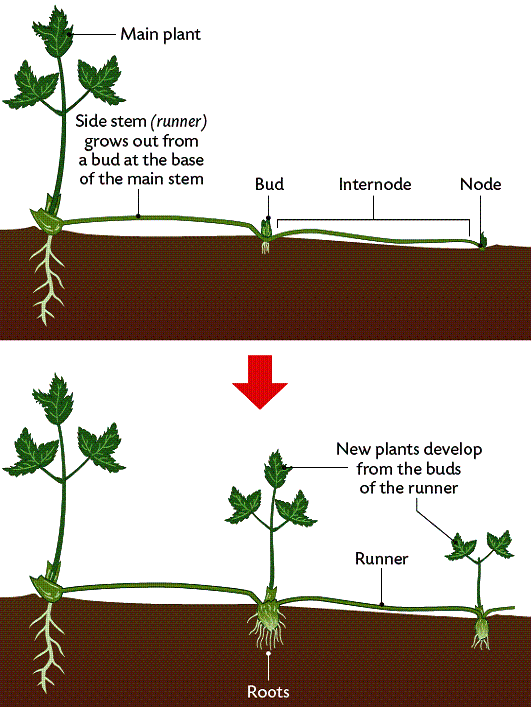Reproduction takes place by one of two methods, asexual or sexual.
- Asexual reproduction involves the production of a new individual(s) from cells or tissues of a pre-existing organism. This process is common in plants and in many microorganisms. It can involve simple binary fission(splitting into two) in unicelluar microbes or the production of specialized asexual spores(孢子).

These processes may be exploited for commercial purposes as in the vegetative propagation of plants. More recently it has been possible to regenerate whole organisms from a single cell. This was first shown in carrots and frogs, but it has now been reported in mammals, and by implication, is possible in all mammals including humans.
Asexually reproduced organisms are genetically identical to the individual from which they were derived. A group of such genetically identical organisms is known as a clone.
Here I found an article at Buzzle , thinking it may help us learn more about animal cloning: http://www.buzzle.com/articles/animal-cloning/. Below is an excerpt of that article.
1, The Process of Animal Cloning Initial attempts at artificially induced Animal Cloning were done using developing embryonic cells. The DNA nucleus was extracted from an embryonic cell and implanted into an unfertilized egg, from which the existing nucleus had already been removed. The process of fertilization was simulated by giving an electric shock or by some chemical treatment method. The cells that developed from this artificially induced union were then implanted into host mothers. The cloned animal that resulted had a genetic make-up identical to the genetic make-up of the original cell←the embryonic cell that contributes the DNA nucleus. Since Dolly, of course, it is now possible to create clones from non-embryonic cells. Now animal cloning can be done both for reproductive and non-reproductive or therapeutic purposes. In the second case, cloning is done to produce stem cells or other such cells that can be used for therapeutic purposes, for example, for healing or recreating damaged organs; the intention is not to duplicate the whole organism. 2. Ethics of Animal Cloning While most scientists consider the process of animal cloning as a major break through and see many beneficial possibilities in it, many people are uncomfortable with the idea, considering it to be 'against nature' and ethically damning, particularly in the instance of cloning human beings. The truth is that most of the general public are not aware of the exact details involved in cloning and as a result there are a lot of misconceptions about the entire matter. In recent times, there have been a spurt of new laws banning or regulating cloning around the world. In some countries, animal cloning is allowed, but not human cloning. Some advocacy groups are seeking to ban therapeutic cloning, even if this could potentially save people from many debilitating illnesses. 3. Points against Animal Cloning In a large percentage of cases, the cloning process fails in the course of pregnancy or some sort of birth defects occur, for example, as in a recent case, a calf born with two faces. Sometimes the defects manifest themselves later and kill the clone. 4. Points for Animal Cloning On the favorable side with successful animal cloning - particularly cloning from an adult animal - you know exactly how your clone is going to turn out. This becomes especially useful when the whole intention behind cloning is to save a certain endangered species from becoming totally extinct.←for more info, please see http://www.buzzle.com/articles/cloning-extinct-animals.html That this is possible was shown by cloning an Indian Gaur in 2001. The cloned Gaur, Noah, died of complications not related to the cloning procedure.
Speaking of saving extinct animals, I couldn’t help but think of Jurassic Park. Although in the movies looks like cloning extinct animals brings threat to humans, or maybe it truly would in reality, the idea of cloning them remains magically attractive to me. Especially, would the biodiversity allow, cloning those who became extinct because of our hunting.
What’s your idea?
- Before I lead you off the topic, let’s go back and talk about Sexual reproduction, which differs from asexual reproduction, in that it involves fusion of cells (gametes←we knew in high school as配子), one derived form each parent, to form a zygote. The genetic processes involved in the production of gametes allow for some genetic changes in offspring.
The production of gametes is referred to as gametogenesis. This may be a complex process, involving sexual differentiation and the production of highly differentiated male and female gametes, or in lower eukaryotes identical cells may fuse–isogamy.
isogamy , in biology, a condition in which the sexual cells, or gametes, are of the same form and size and are usually indistinguishable from each other. Many algae and some fungi have isogamous gametes. In most sexual reproduction, as in mammals for example, the ovum is quite larger and of different appearance than the sperm cell. This condition is called anisogamy. (infoplease.com)
Whatever the biology of the process, one fact is obvious: gametogenesis must involve a halving of the chromosome number, otherwise each succeeding generation would have double the chromosome number of its parents.←That’s why, sexual reproduction is limited to species that are diploid or have a period of their life cycle in the diploid state.
Halving of chromosome numbers is achieved in a specialized form of cell division, meiosis(←we learned in high school as减数分裂), which is only observed in gametogenesis.
We will talk about meiosis more detailedly next section.
![Genetics [8]:reproduction 1](https://apbiology.cn/wp-content/uploads/sites/8/2013/11/genetics-9-dinosuar.jpg)